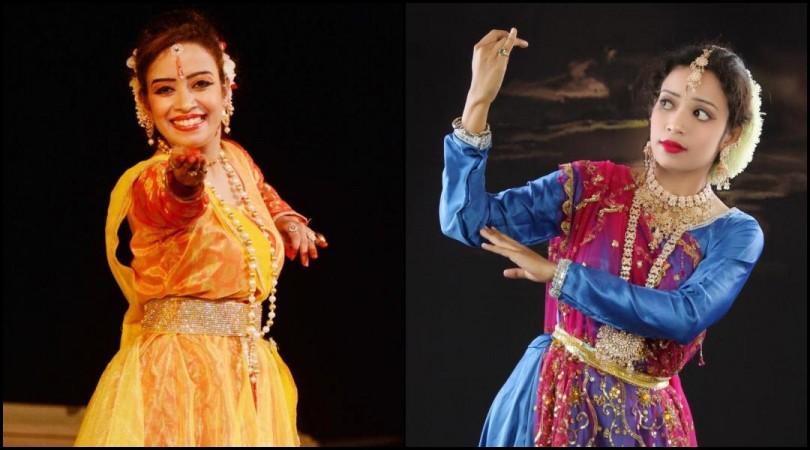
Dance is one of the most beloved art forms. A lot of people aspire to dance and learn over the years, but very few master and grace the art. Dance is not just an art form; it is expressing your emotions without saying a word. From hand movements to body posture to eye contact, every detail is gauged when you perform.
Dance transcends borders, and there is hardly anyone who has not danced their hearts out. With so many dance forms, namely freestyle, classical dancing, rap, hip-hop, or street dancing, Kathak and Bharat Natayam are two such forms of dance that depict Indian culture and heritage. And no one is better than the one who has globalised Kathak and made us proud. One such name is Dr Khusboo Panchal.

Who is Dr. Khushboo Panchal?
Dr Khusboo Panchal is one of the most eminent Kathak dancers in India. She holds a Ph.D. in Kathak and is the founder and director of Nrityaradhna, a temple of DANCE and the principal of Nrityaradhna Music and Arts College. She has travelled the country and charmed audiences with her skill. Her dance is next to godliness. Despite being an outsider, she has paved her way into the hearts of people with hard work and dedication. She has also worked with the late choreographer Saroj Khan.
Not many know that she is also working for specially-abled children, helping and healing them with music.
International Business Times, India exclusively spoke to Dr. Khusboo Panchal, wherein the graceful and prolific Kathak dancer spoke about her journey and struggles. The prolific dancer also shared how westernisation has impacted Kathak and other forms of Indian classical dance.
Tell us about your journey. Have you always wanted to be a dancer?
For me, Kathak means "Katha" i.e. story. My journey started around 30 years ago. I believe I was destined by almighty to be on this journey, as neither I had any background in artists in my family nor did I have any proper guidance. One person who has always been with me in my entire journey is my mother. She has always supported me and fought for me to go ahead and achieve my dreams. I can't even imagine where I am today; without my mom's encouragement, this wouldn't have been possible. I had to keep moving forward. Then I met Dr. Poonam Vyas, my first guru, who trained me in classical Kathak dance. I understood then that once you decide to go for classical training, you have to dedicate yourself to a level that's not just hard work but also worship. Kathak instilled in me the idea that rhythm and "Taal" are needed in life too. Just like how we have three "Lay" or paces of music. I have wholeheartedly given my life to dance and my disciples.
You have worked with renowned choreographer Saroj Khan? How has your experience been?
It was an opportunity of a lifetime, and the moments I spent with the legendary choreographer will forever be etched in my heart and are simply unforgettable. I learned all the nuances of film song choreography, and how to catch the audience's attention without ever crossing the line between art and vulgarity, which we often see in today's time. She was hard-working, upright, and strict with what she wanted in her choreography; her style was charming, effortless, graceful, detailed, and yet so simplistic.
Does Bollywood depict Kathak and other forms of classical dance properly?
Well, I have been trained in Bharatnatyam and Bollywood dance other than my forte Kathak, so I have always enjoyed these. Other than these, regional dances like Rajasthani, Garba, Bhangra, etc are always so much fun to experience as an audience as well as to join in during festivities and taste the flavour and colours of celebrating the Indian way. I have a deep respect for artists who dedicate all their lives to learning and performing classical Indian as well as regional arts, their dedication is what keeps this ancestral heritage alive.
Who is your favourite Bollywood dancer?
Gopi Krishna ji, Vaijayanti Mala ji, and all the retro Bollywood actresses have always enchanted the audiences with their grace and beauty.
With Westernization hovering over Indian culture, how do you plan to make Indian classical dance reach audiences?
There is no doubt that in today's times, the youth of our country are hanging between liberalisation, modernization, westernization, and Indian culture, values, and way of life, which is a heritage that only they have to shoulder for its survival and revival in a changing world. We are in the information age, where we have numerous ways to reach people: social media, podcasts, articles, seminars, webinars, workshops, etc. I believe it's the responsibility of everyone, not just artists like us but organisers, journalists, the government, and parents of this generation, to understand the rich heritage of classical arts and culture that our forefathers have left us to be showcased, talked about, and learn to connect with our roots.
I believe we need more and more platforms for the depiction of classical Indian art to catch the eyes of the masses so that they can cherish how mesmerizing, disciplined, soothing, and tranquil these arts are for audiences. At the same time, it's a challenge for the artists to connect with the next generation, which they should welcome with open arms, find subjects and themes of the time, and produce projects to intrigue the audiences and touch their hearts, without compromising the fundamentals of the art form.


!['Had denied Housefull franchise as they wanted me to wear a bikini': Tia Bajpai on turning down bold scripts [Exclusive] 'Had denied Housefull franchise as they wanted me to wear a bikini': Tia Bajpai on turning down bold scripts [Exclusive]](https://data1.ibtimes.co.in/en/full/806605/had-denied-housefull-franchise-they-wanted-me-wear-bikini-tia-bajpai-turning-down-bold.png?w=220&h=135&l=50&t=40)











!['Had denied Housefull franchise as they wanted me to wear a bikini': Tia Bajpai on turning down bold scripts [Exclusive]](https://data1.ibtimes.co.in/en/full/806605/had-denied-housefull-franchise-they-wanted-me-wear-bikini-tia-bajpai-turning-down-bold.png?w=220&h=135)


![Nayanthara and Dhanush ignore each other as they attend wedding amid feud over Nayanthara's Netflix documentary row [Watch]](https://data1.ibtimes.co.in/en/full/806599/nayanthara-dhanush-ignore-each-other-they-attend-wedding-amid-feud-over-nayantharas-netflix.jpg?w=220&h=135)